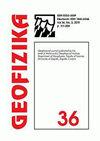Air temperature forecasts' accuracy of selected short-term and long-term numerical weather prediction models over Poland
IF 1.1
4区 地球科学
Q4 GEOCHEMISTRY & GEOPHYSICS
引用次数: 11
Abstract
The article discusses the results of air temperature forecasts from four short-term and two long-term forecasts of numerical weather prediction models. The analysis covered the results of model simulations from January 2015 to January 2016 and compared them at 14 meteorological stations in Poland. The comparison was made based on the most commonly used measures for continuous parameters i.e., ME (mean error), MAE (mean absolute error), RMSE (root mean square error), MSE (mean square error), BIAS and Pearson correlation. In the short time horizon, the best results in the context of the MAE, RMSE, MSE and correlation values were obtained by the Unified Model, although the diagnosed differences between the models are small. All models in the 0–72 h projection horizon reached a correlation of 0.95–0.97 and an MAE in the range of 1.5 °C to 2.1 °C. In the case of long-term forecasts, the HIRLAM model was slightly better than the GFS model. Clearly, in both cases, there is a marked decrease in quality after the fourth and in the following forecast lead days.波兰选定的短期和长期数值天气预报模式的气温预报精度
本文讨论了数值天气预报模式的4种短期预报和2种长期预报的气温预报结果。该分析涵盖了2015年1月至2016年1月的模式模拟结果,并对波兰14个气象站的模拟结果进行了比较。比较基于连续参数最常用的测量方法,即ME(平均误差)、MAE(平均绝对误差)、RMSE(均方根误差)、MSE(均方误差)、BIAS和Pearson相关。在短时间范围内,统一模型在MAE、RMSE、MSE和相关值的背景下获得了最好的结果,尽管模型之间的诊断差异很小。所有模式在0 ~ 72 h投影水平的相关系数为0.95 ~ 0.97,MAE在1.5 ~ 2.1℃范围内。在长期预报方面,HIRLAM模式略优于GFS模式。很明显,在这两种情况下,在第四天和接下来的预测提前日之后,质量都明显下降。
本文章由计算机程序翻译,如有差异,请以英文原文为准。
求助全文
约1分钟内获得全文
求助全文
来源期刊

Geofizika
地学-地球化学与地球物理
CiteScore
1.60
自引率
0.00%
发文量
17
审稿时长
>12 weeks
期刊介绍:
The Geofizika journal succeeds the Papers series (Radovi), which has been published since 1923 at the Geophysical Institute in Zagreb (current the Department of Geophysics, Faculty of Science, University of Zagreb).
Geofizika publishes contributions dealing with physics of the atmosphere, the sea and the Earth''s interior.
 求助内容:
求助内容: 应助结果提醒方式:
应助结果提醒方式:


